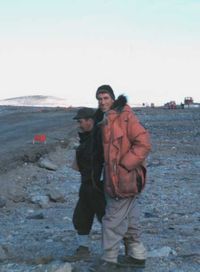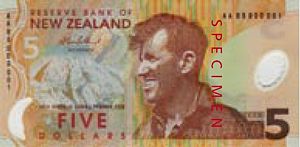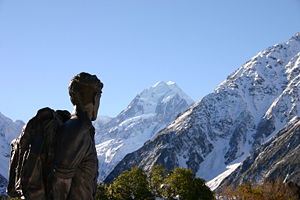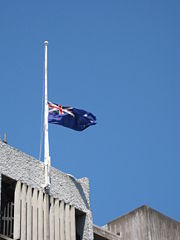Edmund Hillary
2008/9 Schools Wikipedia Selection. Related subjects: Geographers and explorers
| Sir Edmund Hillary | |
 Hillary in 2006
|
|
| Born | 20 July 1919 Auckland, New Zealand |
|---|---|
| Died | 11 January 2008 (aged 88) Auckland, New Zealand |
| Spouse | Louise Mary Rose (1953-1975) June Mulgrew (1989-2008) |
| Children | Peter (1954) Sarah (1955) Belinda (1959-1975) |
| Parents | Percival Augustus Hillary Gertrude Hillary, née Clark |
Sir Edmund Percival Hillary, KG, ONZ, KBE ( July 20, 1919 – January 11, 2008) was a New Zealand mountaineer and explorer. On 29 May 1953 at the age of 33, he and Sherpa mountaineer Tenzing Norgay became the first climbers known to have reached the summit of Mount Everest. They were part of the ninth British expedition to Everest, led by John Hunt.
Youth
Edmund Hillary was born to Percival Augustus Hillary and Gertrude Hillary, née Clark, in Auckland, on 20 July 1919. They moved to Tuakau (south of Auckland) in 1920, after his father (who served at Gallipoli) was allocated land there. His grandparents were early settlers in northern Wairoa in the mid 19th century after emigrating from Yorkshire.
Hillary was educated at Tuakau Primary School and then Auckland Grammar School. He finished primary school two years early, but struggled at high school, achieving only average marks. He was initially smaller than his peers there and very shy so he took refuge in his books and daydreams of a life filled with adventure. His daily train journey to and from high school was over two hours each way, during which he regularly used the time to read. He gained confidence after he learnt to box. At 16 his interest in climbing was sparked during a school trip to Mount Ruapehu. Though gangly at 6 ft 5 in (195cm) and uncoordinated, he found that he was physically strong and had greater endurance than many of his tramping companions.
He studied mathematics and science at Auckland University College, and in 1939 completed his first major climb, reaching the summit of Mount Ollivier, near Mt. Cook in the Southern Alps.
With his brother Rex, Hillary became a beekeeper, a summer occupation that allowed him to pursue climbing in the winter.
World War II
On the outbreak of World War II Hillary applied to join the air force, but withdrew the application before it was considered because he was "harassed by my religious conscience". Following the introduction of conscription on the outbreak of war in the Pacific, in 1943 Hillary joined the RNZAF as a navigator and served on Catalina flying boats. In 1945 he was sent to Fiji and to the Solomon Islands where he was badly burned in a boating accident, after which he was repatriated to New Zealand.
Expeditions
Hillary was part of a British reconnaissance expedition to Everest in 1951 led by Eric Shipton before joining the successful British attempt of 1953.
In 1952 Hillary and George Lowe were part of the British team led by Eric Shipton that attempted Cho Oyu. After that attempt failed due to the lack of route from the Nepal side, Hillary and Lowe crossed the Lho-La into Tibet and reached the old Camp II, on the northern side, where all the pre-war expeditions camped.
1953 Everest Expedition
The route to Everest was closed by Chinese-controlled Tibet, and Nepal only allowed one expedition per year. A Swiss expedition (in which Tenzing Norgay took part) had attempted to reach the summit in 1952 but was turned back by bad weather 800 feet (240 m) from the summit. During a 1952 trip in the Alps Hillary discovered he and his friend George Lowe had been invited for the approved British 1953 attempt and immediately accepted.
Shipton was named as leader but was replaced by Hunt. Hillary considered pulling out, but both Hunt and Shipton talked him into remaining. Hillary was intending to climb with Lowe but Hunt named two teams for the assault: Tom Bourdillon and Charles Evans; and Hillary and Tenzing. Hillary therefore made a concerted effort to forge a working friendship with Tenzing.
The Hunt expedition totaled over 400 people, including 362 porters, twenty Sherpa guides and 10,000 lbs of baggage, and like many such expeditions, was a team effort. Lowe supervised the preparation of the Lhotse Face, a huge and steep ice face, for climbing. Hillary forged a route through the treacherous Khumbu Icefall.
The expedition set up base camp in March 1953. Working slowly it set up its final camp at the South Col at 7,900 metres (25,900 ft). On 26 May Bourdillon and Evans attempted the climb but turned back when Evans's oxygen system failed. The pair had reached the South Summit, coming within 300 vertical feet (91 m) of the summit. Hunt then directed Hillary and Tenzing to go for the summit.
Snow and wind held the pair up at the South Col for two days. They set out on 28 May with a support trio of Lowe, Alfred Gregory and Ang Nyima. The two pitched a tent at 8,500 metres (27,900 ft) on 28 May while their support group returned down the mountain. On the following morning Hillary discovered that his boots had frozen solid outside the tent. He spent two hours warming them before he and Tenzing attempted the final ascent wearing 30- pound (14 kg) packs. The crucial move of the last part of the ascent was the 40-foot (12 m) rock face later named the "Hillary Step". Hillary saw a means to wedge his way up a crack in the face between the rock wall and the ice and Tenzing followed. From there the following effort was relatively simple. They reached Everest's 29,028 ft (8,848 m) summit, the highest point on earth, at 11:30 am. As Hillary put it, "A few more whacks of the ice axe in the firm snow, and we stood on top."
They spent only about 15 minutes at the summit. They unsuccessfully looked for evidence of the 1924 Mallory expedition. Hillary took Tenzing's photo, Tenzing left chocolates in the snow as an offering, and Hillary left a cross that he had been given. Because Tenzing did not know how to use a camera, there are no pictures of Hillary there.
The two had to take care on the descent after discovering that drifting snow had covered their tracks to complicate the task. The first person they met was Lowe, who had climbed up to meet them with hot soup.
| “ | Well, George, we finally knocked the bastard off. | ” |
|
—Hillary's first words to lifelong friend George Lowe on returning from Everest's summit |
||
News of the successful expedition reached Britain on the day of the coronation of Queen Elizabeth II. The group was surprised by the international acclaim that they received upon arriving in Kathmandu. Hillary and Hunt were knighted by the young queen, while Tenzing received the British Empire Medal.
After Everest
Hillary climbed ten other peaks in the Himalayas on further visits in 1956, 1960–61 and 1963–65. He also reached the South Pole as part of the Commonwealth Trans-Antarctic Expedition, for which he led the New Zealand section, on 4 January 1958. His party was the first to reach the Pole overland since Amundsen in 1911 and Scott in 1912, and the first ever to do so using motor vehicles. In 1977, he led a jetboat expedition, titled "Ocean to Sky", from the mouth of the Ganges River to its source.
In 1979, as he had done previously, Hillary was scheduled to act as a commentator on the ill-fated Air New Zealand Flight 901, an Antarctic sightseeing flight, but had to pull out due to work commitments elsewhere. He was replaced by his close friend Peter Mulgrew, who perished as the aircraft crashed on Mount Erebus, killing all 257 on board. He later married Mulgrew's widow.
Hillary took part in the 1975 general election, as a member of the " Citizens for Rowling" campaign. His involvement in this campaign was seen as precluding his nomination as Governor-General, with the position instead being offered to Keith Holyoake in 1977. However, in 1985 he was appointed New Zealand High Commissioner to India (concurrently High Commissioner to Bangladesh and Ambassador to Nepal) and spent four and a half years based in New Delhi.
In 1985 he accompanied Neil Armstrong in a small twin-engined ski plane over the Arctic Ocean and landed at the North Pole. He thus became the first man to stand at both poles and on the summit of Everest.
In January 2007, Hillary travelled to Antarctica to commemorate the 50th anniversary of the founding of Scott Base. He flew to the station on 18 January 2007 with a delegation including the Prime Minister. While there he called for the British government to contribute to the upkeep of Scott's and Shackleton's huts.
On 22 April 2007 while on a trip to Kathmandu he is reported to have suffered a fall. There was no comment on the nature of his illness and he did not immediately seek treatment. He was hospitalized after returning to New Zealand.
Public recognition
Hillary was created a Knight Commander of the Order of the British Empire (KBE) on 6 June 1953; a member of the Order of New Zealand (ONZ) in 1987; and a Knight of the Order of the Garter (KG) on 22 April 1995. He was also awarded the Polar Medal for his part in the Commonwealth Trans-Antarctic Expedition. Various streets, schools and organisations around New Zealand and abroad are named after him. A few examples are Hillary College ( Otara), Edmund Hillary Primary School ( Papakura) and the Hillary Commission (now SPARC).
In 1992 Hillary appeared on the updated New Zealand $5 note; Hillary was the only New Zealander to appear on a banknote during his or her own lifetime. International convention for banknotes was to use the faces of only current heads of state and deceased individuals. The Reserve Bank governor at the time, Don Brash, had originally intended to use a deceased sportsperson on the $5 note but could not find a suitable candidate. Instead he broke with convention by requesting and receiving Hillary's permission — along with an insistence from Hillary to use Aoraki/Mount Cook rather than Mount Everest in the backdrop. The image also features a Ferguson TE20 tractor like the one Hillary used to reach the South Pole on the Commonwealth Trans-Antarctic Expedition.
To mark the occasion of the 50th anniversary of the first successful ascent of Everest the Nepalese Government conferred honorary citizenship upon Hillary at a special Golden Jubilee celebration in Kathmandu. He was the first foreign national to receive such an honour from the Nepalese government.
A 2.3-metre (7.5 ft) bronze statue of Sir Ed was installed outside The Hermitage hotel at Mt Cook village, New Zealand, in 2003.
Family life
Hillary married Louise Mary Rose on 3 September 1953, soon after the ascent of Everest. A shy man, he relied on his future mother-in-law to propose on his behalf. They had three children: Peter (1954), Sarah (1955) and Belinda (1959).
In 1975 while en route to join Hillary in the village of Phaphlu, where he was helping build a hospital, Louise and Belinda were killed in a plane crash near Kathmandu airport shortly after take-off.
Hillary married June Mulgrew, the widow of his close friend Peter Mulgrew, on 21 December 1989.
His son Peter Hillary has also become a climber, conquering Everest in 1990. In April 2003 Peter and Jamling Tenzing Norgay (son of Tenzing) climbed Everest as part of a 50th anniversary celebration. Hillary had six grandchildren, including Amelia Hillary who is also involved in Hillary's work in the Himalayas.
Philanthropy
Following his ascent of Everest he devoted much of his life to helping the Sherpa people of Nepal through the Himalayan Trust, which he founded. Through his efforts many schools and hospitals were built in this remote region of the Himalayas. He was the Honorary President of the American Himalayan Foundation, a United States non-profit body that helps improve the ecology and living conditions in the Himalayas.
Hillary spoke of his disdain for the attitudes displayed by many modern mountaineers. In particular he publicly criticized New Zealander Mark Inglis and 40 other climbers who, in various groups, left British climber David Sharp to die in May 2006. He said:
I think the whole attitude towards climbing Mount Everest has become rather horrifying. The people just want to get to the top, it was wrong if there was a man suffering altitude problems and was huddled under a rock, just to lift your hat, say good morning and pass on by.
He also told the New Zealand Herald that he was horrified by the callous attitude of today's climbers:
They don't give a damn for anybody else who may be in distress and it doesn't impress me at all that they leave someone lying under a rock to die.
Death
On 11 January 2008, Sir Edmund Hillary died of heart failure at the Auckland City Hospital at around 9 am NZDT ( 10 January at 20:00 UTC) at the age of 88.
Hillary's death was announced by New Zealand Prime Minister Helen Clark at around 11:20 am. She stated that his passing was a "profound loss to New Zealand". His death was recognised by the lowering of flags to half-mast at the New Zealand Parliament, Auckland Harbour Bridge and at Scott Base in Antarctica. Actor and adventurer Brian Blessed, who attempted to climb Everest three times, described Sir Edmund as a "kind of titan". He was in hospital at the time of his death but was expected to come home that day according to his family.
The New Zealand press praised Sir Edmund in their obituaries. " We will not see his kind again" was the title of the obituary on TVNZ's website, which referred to him as "the quintessential Kiwi - humble, hard-working and honest". TVNZ also set up a " message board" for comments by the public, and stated they would be compiled into "a book of remembrance which will be presented to Sir Ed's family". Stuff.co.nz described him as " A man Kiwis loved to love" and "a darned nice guy". The New Zealand Herald titled " World's media honours Hillary", and published a compilation of praise from foreign media.
A state funeral has been planned for 22 January. It is known that Hillary wished to be cremated, and for his ashes to be spread over Waitemata Harbour in Auckland.



